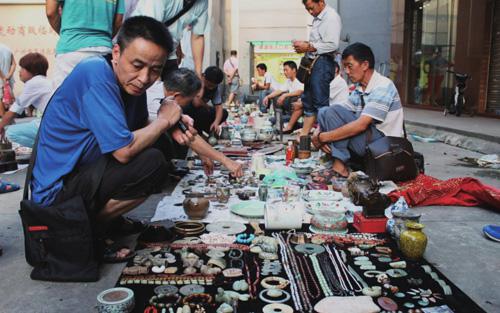Bazaar Experience
2018-06-25ByLaurenceCoulton
By Laurence Coulton
The circumstances which brought me to Guangzhou, capital of south Chinas Guangdong Province, in 2013 on my fi rst visit to China began thousands of years before. As a student of history at a British university, I had begun to grow weary of the usual furnishings of traditional historical education in the West. The Battle of Salamis, the Fall of Rome, the French Revolution, all hold great import in the narrative underpinning Western civilization, but they all seemed blandly familiar, the voices of their witnesses and narrators banally like my own.
It was then that my mind began to wander east, discovered China and never looked back. With no prior understanding of the country beyond a fl eeting knowledge of the menu at a Chinese restaurant in the village where I grew up, I enrolled in a course at another university to study the Qing Dynastys(1644-1911) mercantile interactions with Europe, and so began a love affair with Chinese history which has lasted to the present day. The arcane practices of divination in the Shang Dynasty (1600-1100 B.C.), transcontinental trade in the Tang Dynasty (618-907), the suicide of the last Ming Emperor in the gardens behind the Forbidden City in 1644—at last I had found the kind of history to get excited about!
Once I moved to China, I set out at once to try to discover extant traces of this thrilling past. During my initial excursions, I was surprised to discover the pristine condition of the countrys heritage sights, but I soon learned that most had been reconstructed in very recent years or months. In the West, we see our past as preserved in ruined buildings and broken walls, to alter them in any way beyond what is necessary for their preservation is to be guilty of some blasphemous crime against history. To my knowledge, in China no such concept exists, and a lick of paint can vastly improve a thousand-yearold temple, just as regrouting will benefi t not only the structural integrity, but also the aesthetics of a fi ve century-old wall. Stuck in my European ways, I found it hard to satisfy my craving for Chinas past in these renovated structures, and so I had to look elsewhere to get my fi ll.
My first experience with a Chinese antique market was in the twisting lanes and alleyways of Guangzhous Liwan District. Flanked by stalls on either side, the streets were gloriously cramped as the cries of hawkers noisily peddling their wares ricocheted off the walls. Ancient swords crumbling with rust lined one stand, a selection of coins were laid out on another, and in one store a brass telescope bearing an inscription signed by an employee of the British East India Company was displayed. From my days studying the Canton Trade in the UK, it was easy to imagine this valuable article being seized in some quarrel or skirmish as tensions ran high between the British and the Chinese in the 19th century. Yet for all the supposedly historical items, it was not the objects themselves which so ignited my excitement. Coming from a country where the purchase of anything invariably takes the prosaically modern form of fi xed prices and ubiquitous brands, to one where apparently everything outside of the shopping malls could be negotiated, I was amazed by the market itself.
I have since visited many such markets across China, and make it my first order of business when arriving in a new place to research their existence and location. They come in a fascinating array of styles and layouts, trinket-laden rugs tessellating across car parks, under bridges and over old city walls, with others formalized in large multistory, air-conditioned malls. I seldom buy anything, principally because Im well aware that most of the items for sale are fake, especially those with prices low enough for me to afford, but also because it is the composition of the scene itself which I so enjoy, its characters and dramas, rather than the things themselves.
Yet that is not to say that the stuff itself does not have its own particular charm. Vintage cameras of unfamiliar origin with hazy viewfinders through which someone once captured snapshots of a world vastly different from that of today; ritual objects of bronze and jade telling miniature stories of a past society; others unidentifi able and enigmatic; others simply beautifully designed. While the countrys palaces and temples, walls and parks remain an impressive and indispensable means through which to access its long history, for those looking to step into the mysterious and thrilling world of Chinas past, a walk through an antique market is a good place to start.
